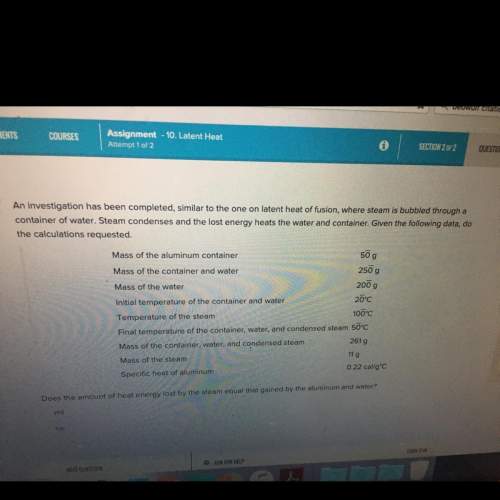
An investigation has been completed, similar to the one on latent heat of fusion, where steam is bubbled through a container of water. steam condenses and the lost energy heats the water and container. given the following data, do the calculations requested.
mass of the aluminum container 50 g
mass of the container and water 250 g
mass of the water 200 g
initial temperature of the container and water 20°c
temperature of the steam 100°c
final temperature of the container, water, and condensed steam 50°c
mass of the container, water, and condensed steam 261 g
mass of the steam 11 g
specific heat of aluminum 0.22 cal/g°c
heat energy gained by the container heat =
770 cal
550 cal
330 cal
220 cal
heat energy gained by the water
14,000 cal
10,000 cal
6000 cal
4000 cal
what is the latent heat of vaporization for water?
latent heat =
79.7 kcal/kg
5900 kcal/kg
540 kcal/kg
does the amount of heat energy lost by the steam equal that gained by the aluminum and water?
yes
no
total heat lost by the steam as it condenses and reaches 50°c.
heat =
given the data above, determine the total heat energy gained by the container and water.
2900 cal
6300 cal
6500 cal
7800 cal
latent heat lost by the steam as it condenses to water at 100°c.
heat =
550 cal
6500 cal
5900 cal


Answers: 2


Another question on Physics

Physics, 21.06.2019 19:20
Aferris wheel is a vertical, circular amusement ride with radius 9 m. riders sit on seats that swivel to remain horizontal. the ferris wheel rotates at a constant rate, going around once in 9 s. consider a rider whose mass is 56 kg. at the bottom of the ride, what is the perpendicular component of the rate of change of the rider's momentum? at the bottom of the ride, what is the vector force exerted by the seat on the rider?
Answers: 1

Physics, 22.06.2019 03:10
Athin plate moves between two parallel, horizontal, stationary flat surfaces at a constant velocity of v = 7.5 m/s. the two stationary surfaces are spaced 4 cm apart, and the medium between them is filled with oil whose viscosity is 0.9 n·s/m2. the part of the plate immersed in oil at any given time is 2 m long and 0.5 m wide. if the plate moves through the mid-plane between the surfaces, determine the force required to maintain this motion. what would your response be if the plate was 1 cm from the bottom surface (h2) and 3 cm from the top surface (h1)? if the plate moves through the mid-plane between the surfaces, the force required to maintain the motion will be n. if the plate was 1 cm from the bottom surface (h2) and 3 cm from the top (h1) surface, the force required to maintain the motion would be n.
Answers: 2

Physics, 22.06.2019 05:10
What do elements in a family tend to share. a.) similar periods b.) similar groups c.) similar atomic symbols d.) similar chemical properties and characteristics
Answers: 2

Physics, 22.06.2019 11:00
Afisherman notices that his boat is moving up and down periodically without any horizontal motion, owing to waves on the surface of the water. it takes a time of 2.20 s for the boat to travel from its highest point to its lowest, a total distance of 0.670 m . the fisherman sees that the wave crests are spaced a horizontal distance of 5.80 m apart. (a) how much is the wavelength? (b) find the period of the wave. (c) how fast are the waves traveling? (d) what is the amplitude a of each wave?
Answers: 3
You know the right answer?
An investigation has been completed, similar to the one on latent heat of fusion, where steam is bub...
Questions

Health, 02.10.2020 19:01

Mathematics, 02.10.2020 19:01




Mathematics, 02.10.2020 19:01

Mathematics, 02.10.2020 19:01

English, 02.10.2020 19:01

English, 02.10.2020 19:01

English, 02.10.2020 19:01

Biology, 02.10.2020 19:01

Business, 02.10.2020 19:01


Social Studies, 02.10.2020 19:01

History, 02.10.2020 19:01

Mathematics, 02.10.2020 19:01

History, 02.10.2020 19:01

History, 02.10.2020 19:01

Mathematics, 02.10.2020 19:01

Mathematics, 02.10.2020 19:01



